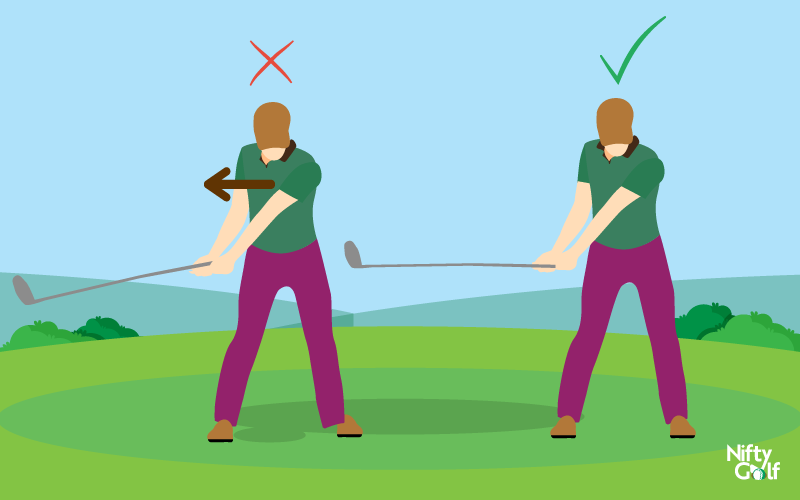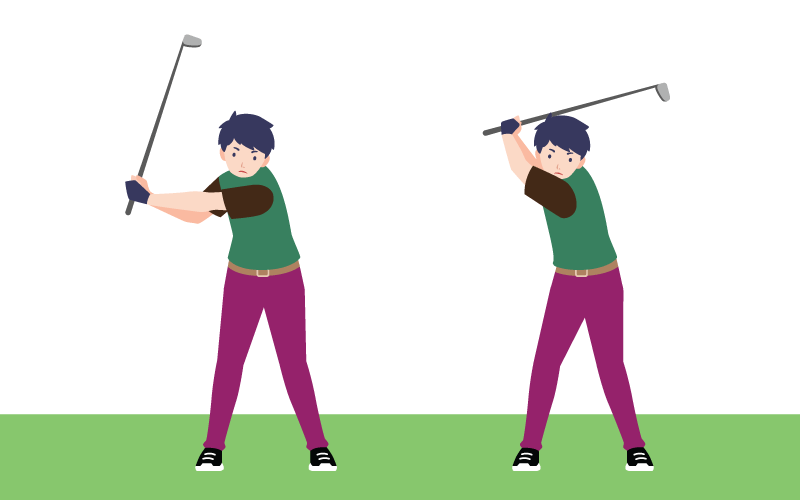Having a perfect backswing in golf is essential to have a perfect golf swing. It’s a position of your full swing. It will affect the whole swing system if you can’t do it correctly. Backswing golf means moving the club from the back of your ball to the top of the swing.
Creating a proper backswing can also change your game. Because it helps you to perfect your golf ball hits and increases the chance of hitting closer to the hole. The question is, how? Are there any golf backswing tips? Yes, definitely! Learn the keys just in 4 simple steps.
Table of Content
How to Create a Perfect Golf Backswing?
To create a perfect swing plane, you should have a correct golf swing takeaway and your lower body, especially your hips after the takeaway. Then you should keep your left heel on the ground while moving your arms. Whether you should bend your both knees or not is also important to know for a proper golf backswing.
Let’s know in detail.
1. Correct the golf swing takeaway

Takeaway is the first movement of golf backswing. It indicates the position when your golf club remains parallel to the ground.
If you make any mistakes in this first movement, it will result in more errors in the rest of your golf swing. To avoid mistakes, you need to know how to properly grip a golf club.
While moving the club for swinging back, it should neither be too far to the right of you nor too far to the left. It should just be on the parallel line. So, first, make sure you get the takeaway right.
2. Rotate your hips after takeaway

You need to rotate your hips immediately after performing takeaway. Don’t let your hips remain straight until you reach the top. Otherwise, it will be an all-arms swing that won’t allow you to correct your golf ball position for impact.
While rotating your hips, you shouldn’t let your head remain straight or move down. Instead, keep it flexible according to your hip rotations.
3. Keep your left arm straight and left heel on the ground

While addressing the ball, don’t bend your left elbow. Keep it straight till the moment your club reaches the top. Otherwise, it will result in an incorrect backswing.
Don’t lift your left heel from the ground. If you lift the heel to take your clubhead back further thinking that it will generate more clubhead speed, you are doing it wrong.
Keeping it on the ground can increase your swing speed. It’s as important as keeping the left arm straight. Otherwise, the chance of missing the hole increases. So make sure you are trying properly to keep score in golf.
4. Keep your knees bent
From the setting to the movement of your club, your left elbow will automatically retain some flex. At that moment, don’t keep your right knee straight. Bend it too. And if possible, keep both knees at the same bent angle or close to it.
If you can skip the straight position of your right knee, it will change the angle of your hips and swing path. Otherwise, you cannot ignore the right knee swing errors.
Your weight shouldn’t move towards the bent left knee that can move your left foot too much. Let your left knee point towards the ball or in the middle of your stance.
Golf Backswing Video Tutorial
What’s the Purpose of Golf Backswing?
The purpose of a golf backswing is to create clubhead speed for impact. To do that, the club needs a certain distance from the golf ball so it can gain some energy. And this energy creates clubhead speed for impact.
The more you will practice backswing, the more you can learn how to stand, how to hold the club. This will help you have a consistent result.
Why is Improving Golf Backswing So Important?
Improving golf swing plane is very important to give you a proper setup. A proper setup means having a correct takeaway, a solid golf club grip, a proper wrist angle, proper hip, and arm movements.
If you can take a correct position and solid grip from takeaway to the top, it will give your club proper movement. And if the club moves appropriately, you can have a correct backswing.
Those who can perform backswing perfectly are more likely to hit directly into the hole than those who can’t. In a word, improving backswing is important for improving your game.
10 Golf Swing Tips to Improve Your Swing
Here are 10 golf swing tips that will improve your swing:
- Develop a Proper Stance: Keep your legs and shoulders width apart, adjusting slightly based on the club’s length. Ensure your stance is comfortable and balanced.
- Master the Grip: Choose between interlock, overlap, and baseball grips. Practice rotating the clubface and finding a grip that feels natural and balanced.
- Focus on Footwork: Emphasize the importance of footwork in creating efficient power sources for your swing. Practice to master balance during both backswing and forward swing.
- Perfect the Backswing: Work on a correct takeaway, rotate your hips afterward, keep your left arm straight and left heel on the ground, and ensure your knees are bent.
- Follow Through the Swing: Feel like you’re pulling the club top during the downswing. Allow your arm/shaft angle to expand to 90 degrees, then relax through the impact area.
- Understand Swing Types: Learn about swing types like Inside-out and Square-to-square, and practice finding which works best for you.
- Practice Controlled Shots: Work on deliberate shots like slicing the ball on purpose or hitting a fade by adjusting your grip, stance, and swing technique.
- Increase Swing Speed: Focus on turning legs, knees, hips, torso, and shoulders to generate power and transfer body weight into shot power. Practice full swings while maintaining balance.
- Control Your Slice: Aim straight, choose the right club, reconstruct your grip, and practice a proper swing technique to straighten shots and avoid slicing.
- Use a Swing Analyzer: Incorporate technology like swing analyzers or trackers to get detailed feedback on your swing and make informed improvements.
How Can You Overcome Your Weakness in Backswing?
You can overcome your weakness by following these five simple steps:
First, learn, learn and learn. Nothing can beat your knowledge. The more you know, the more you can overcome your weakness.
Make your setup correct. Because backswing starts from setup. Setup includes how far you should stand from the golf ball, is it too close or too far, how to hit the golf ball with power, how much height is required for longer and shorter clubs, etc.
Maintain your body position. This includes where your knees should be, where your feet should line up, whether you should rotate your hips or not, etc. The wrong posture restricts your movements and makes your backswing challenging.
Now, what you need is to have a solid grip. Neither too strong, nor too weak. The wrong grip leads to an incorrect takeaway and eventually an incorrect posture.
Finally, make sure your arms move in a proper way. If they move incorrectly, it creates swing faults. Even for a single wrong movement, the whole backswing results in an error.
Conclusion
The backswing is nothing but the rotation of your shoulders and body. If you once learn the proper golf backswing technique, you can perfect your whole swing and hit straight. Hope the above-mentioned steps can be helpful if you are struggling with your backswing. Follow the steps, learn the purposes of golf backswing, know about its importance, find out your weakness and overcome it. These 4 things will really help you bring success and enjoy golfing.
